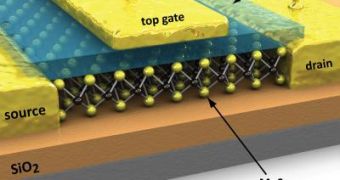Introduced as a major breakthrough in chip manufacturing, graphene doesn't seem to have all that much going for it lately, as after IBM said that the material wouldn't replace silicon in future transistors, another hurdle comes its way, researchers just discovering that molybdenite is far better suited for this role.
Molybdenite is a mineral that is abundant in nature and is often used as an element in steel alloys or as an additive in lubricants.
However, researchers at the Laboratory of Nanoscale Electronics and Structures (LANES) have found that molybdenite could also be used for the fabrication of very small transistors.
According to EPFL Professor Andras Kis, as molybdenite is a two-dimensional material that carries a size advantage over silicon (which is a 3D material) since it can enable chip manufacturers to produce sheets as thin as 0.65-nanometer, compared to the 2 nanometer-thick silicon sheets.
Furthermore, the material is also more energy efficient than silicon since it uses 100,000 times less energy in standby mode.
When compared to graphene, molybdenite has an important advantage as the material has the so-called "band gaps," that are used in order to turn a transistor on and off.
“Unlike silicon, graphene does not have an energy gap, and therefore, graphene cannot be “switched off," resulting in a small on/off ratio,” said one IBM researcher previously when talking about the material's role in future transistors.
The lack of these gaps means that such a transistor could never be actually turned off, thus raising energy efficiency and gate signaling problems.
Unfortunately, molybdenite's use in transistor manufacturing is still in the earliest of stages so it may take some time until the first prototypes are produced.
Graphene, however, has already been used for manufacturing such prototypes, IBM demonstrating a graphene transistor that runs at 100GHz while UCLU researchers have developed a graphene transistor with a cut-off frequency of 300GHz. (via Smart Planet)

 14 DAY TRIAL //
14 DAY TRIAL //